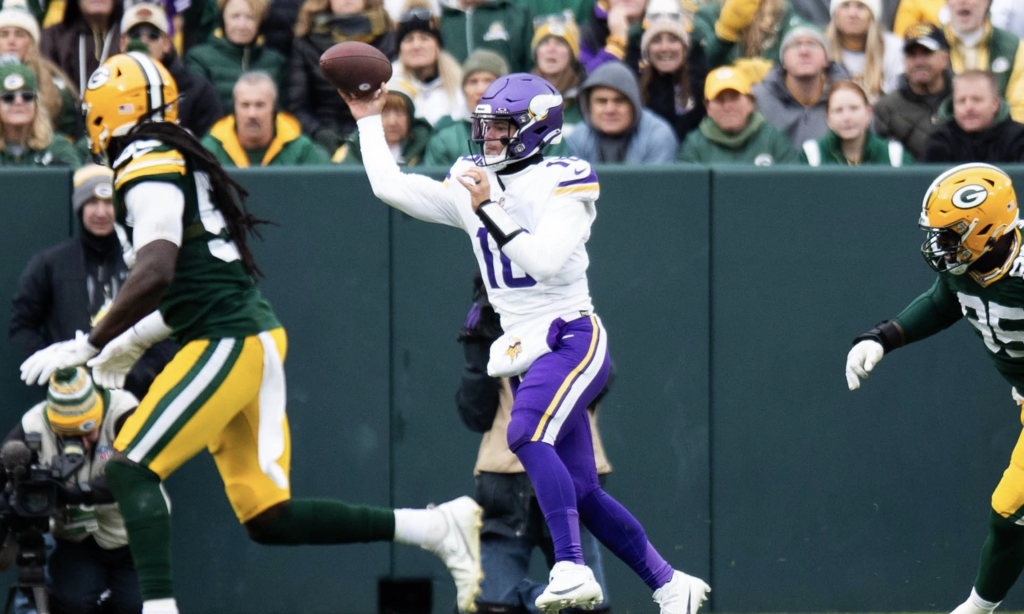Fourteen quarterbacks have started in the Super Bowl after not being the starting quarterback on their team at the beginning of the regular season, so the message to Vikings quarterbacks Jaren Hall and Josh Dobbs is: It can be done.
Of the 14, seven of them led their teams to the final game after taking over for an injured starter: Nick Foles, Colin Kaepernick, Tom Brady, Jeff Hostetler, Doug Williams, Jim Plunkett and Vince Ferragamo. Overall, here’s the historic list of 14:
- Nick Foles, Eagles, 2017 – replaced injured Carson Wentz
- Tom Brady, Patriots, 2016 – suspended 4 games for Deflategate
- Colin Kaepernick, 49ers, 2012 – replaced injured Alex Smith
- Ben Roethlisberger, Steelers, 2010 – suspended 6 games for personal conduct
- Jake Delhomme, Panthers, 2003 – took over for Rodney Peete in Week 3
- Tom Brady, Patriots, 2001 – replaced injured Drew Bledsoe
- Trent Dilfer, Ravens, 2000 – took over for Tony Banks in Week 9
- Jeff Hostetler, Giants, 1990 – replaced injured Phill Simms
- Doug Williams, Redskins, 1987 – started 5 games before chosen as playoff QB
- Jim Plunkett, Raiders, 1980 – replaced injured Dan Pastorini
- Vince Ferragamo, Rams, 1979 – replaced injured Pat Haden
- Terry Bradshaw, Steelers, 1974 – took over for Joe Gilliam in Week 7
- Roger Staubach, Cowboys, 1971 – took over for Craig Morton
- Joe Kapp, Vikings, 1969 – took over for Gary Cuozzo in Week 2
Hall or Dobbs is replacing Kirk Cousins after Cousins led the Vikings to a 4-4 record before tearing his Achilles tendon Sunday in Green Bay.
Hall will start for the Vikings this Sunday against the Falcons, so Dobbs’ first start – if Hall doesn’t outright win the job – could come in Week 10 against the Saints.

Whether it’s Hall or Dobbs, Minnesota’s backup-turned-starting QB will be surrounded by a tremendous supporting cast, with one of the league’s top offensive lines and outstanding receivers in Justin Jefferson (assuming he returns from IR in the next couple of weeks), Jordan Addison, K.J. Osborn and T.J. Hockenson. Minnesota’s defense has also allowed just 14.3 points per game over the last three weeks.
The 2023 Vikings are set up nicely for a backup QB, just like the 14 players listed above were when their respective numbers were called.
The most recent example of backup leading a team to the Super Bowl is Nick Foles in 2017. He didn’t take over until Carson Wentz was injured in Week 14. Foles then guided the Eagles to a Super Bowl win over the Patriots in Minneapolis.
In 2012, Alex Smith suffered a concussion and the 49ers replaced him with Colin Kaepernick, who started the final seven games of the season and led San Francisco to the Super Bowl, where they lost 34-31 to the Ravens.
In 2001, the Patriots dynasty began when Tom Brady took over after Drew Bledsoe was concussed in Week 3 against the New York Jets.
Jeff Hostetler didn’t take over until Simms broke his foot in Week 15. That Giants team had one of the great defenses in NFL history, led by Hall of Fame linebacker Lawrence Taylor. They beat the Bill 20-19 in the Super Bowl.
Doug Williams was the MVP of the 1987 Redskins Super Bowl win over Denver after he started just five games in the regular season only to have coach Joe Gibbs choose him as the playoff starter over Jay Schroeder, who was dealing with a shoulder injury.
In 1980, Dan Pastorini was the starting quarterback for the Oakland Raiders when he was injured and Jim Plunkett started the final 11 games and ultimately led the Raiders to a 27-10 win over the Eagles in the Super Bowl, and Plunkett was named Super Bowl MVP.
And Vince Ferragamo replaced Pat Haden midway through the ’79 season and those Rams finished 9-7 before losing to the Steelers in the Super Bowl.
It’s been done before and it will be done again. It’s just a matter of which backup quarterback is next to join that historic list.
Note: If you’re wondering why Kurt Warner isn’t on this list it’s because he started Week 1 of the 1999 season after Trent Green was injured in the preseason.








